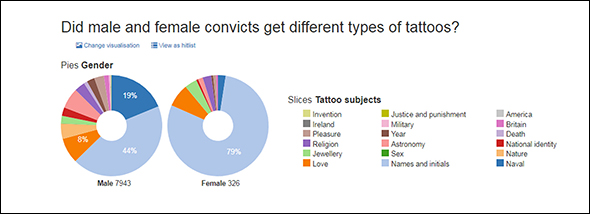Convict datasets updated
It’s been — and continues to be — a terrible terrible fire season Down Under, and our fellow genealogists need some relief.
And while The Legal Genealogist can do nothing except watch in horror as the news from Australia continues to be grim,1 maybe a few of our colleagues can use a little distraction with a different kind of news.
News like the expansion of an absolutely terrific online resource for folks researching their convict ancestors.
The website is called Digital Panopticon, and it describes itself simply: “The Digital Panopticon website allows you to search millions of records from around fifty datasets, relating to the lives of 90,000 convicts from the Old Bailey, to search individual convict life archives, explore and visualise data, and to learn more about crime and criminal justice in the past.”2
As of this month, the website was updated with the addition of two datasets on convict tattoos, a new search feature for searching by convict occupations, and more ways to visualize the data.
And it’s simply great fun to use, whether you have convict ancestors or not and even whether you have English or Australian ancestors to research — it’s just wonderful as an eye into the criminal justice system in England and the transportation system of the time. Just its links to the records of the Old Bailey would make it worth spending time here…
The new datasets cover convict tattoos recorded on 58,000 convicts between 1793-1925, both those transported to Australia and those imprisoned in Britain. That by itself would be an amazing bit of work — but you have to check out what the site calls the Visualisation Gallery.3
You can see, for example, how the subjects of tattoos changed over time, or what the likelihood was of having a tattoo about love if the person also had a tattoo about the military, or how likely it was that somebody had a name or initials as a tattoo over time. And there are visualizations for tattoos based on the convict’s religion or place of birth or occupation and where the tattoos were located on the body.4
And there’s a terrific explanation of these tattoos in an article by Digital Panopticon co-investigator Professor Robert Shoemaker of the University of Sheffield and research associate Dr. Zoe Alker of the University of Liverpool if you want to know more about the tattoos in general.[x. Robert Shoemaker and Zoe Alker, “How tattoos became fashionable in Victorian England,” The Conversation, posted 12 Dec 2019 (https://theconversation.com/ : accessed 19 Dec 2019).]
Other visualizations of data presented in the Visualisation Gallery along with the tattoo data include things like most common criminal sentences changes over time, length of time between conviction and transportation, ages of arrival, and punishment outcomes.
Digital Panopticon is the brainchild of a group of English academics led by Professor Barry Godfrey of the University of Liverpool, with co-investigators Professor Robert Shoemaker, University of Sheffield, Professor Tim Hitchcock, University of Sussex, Professor Deborah Oxley, University of Oxford, and Professor Hamish Maxwell Stewart, University of Tasmania. They partnered with data providers like Findmypast, Ancestry, the London Metropolitan Archives and the Tasmanian Archives — just to name a few — to present huge amounts of data in searchable form.
It offers a wide range of background and contextual information in the Historical Background pages, and study guides on subjects such as women, juvenile offenders and family history in the Research and Teaching pages.
And it’s just plain fun.
Go spend some time playing on the Digital Panopticon.
You won’t regret it.
Cite/link to this post: Judy G. Russell, “A Down Under distraction,” The Legal Genealogist (https://www.legalgenealogist.com/blog : posted 20 Dec 2019).
SOURCES
- See e.g. the unbelievable map at MyFirewatch. ↩
- “The Project,” Digital Panopticon (https://www.digitalpanopticon.org/ : accessed 19 Dec 2019). ↩
- Sorry. I’m American. I can’t use an S where a Z belongs. And all those extra Us in colour, humour and the like… Oy! ↩
- And I have to admit, I’m enormously amused by the fact that men are shown as having tattoos on the breast… and women on the chest. See “Top 20 male/female body parts,” Visualisation Gallery, Digital Panopticon (https://www.digitalpanopticon.org/ : accessed 19 Dec 2019). ↩




Thank you for thinking of your colleagues downunder Judy. Yes, it is pretty grim at the moment with the fires and the drought across much of the country. On a lighter note, I agree with you about the Digital Panopticon. It is an amazing resource and a must “go to” when researching convict ancestors. The Digital Panopticon has made it even easier to research convicts with an almost one-stop shop from the time of arrest/trial in the UK through to the end of their servitude. I was fortunate to study under Dr Hamish Maxwell who was head of the department when I did my Diploma in Family History at the University of Tasmania. He has been instrumental in collating and analysing convict data and making it available for social historians.
Thank you for sharing your legal and genealogical knowledge this year. I look forward to your blog continuing in 2020.
Regards
Therese
Thanks for the kind words… and good luck with these terrible fires…